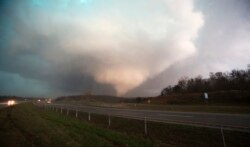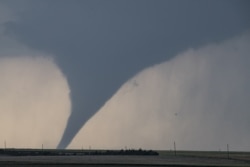Following a severe tornado earlier this year in Alabama that killed 23 people, scientists interviewed residents in the area to find out why the storm was so deadly and made an important finding: almost everyone had heard the warnings about the impending storm and had enough time to seek shelter, but some chose not to.
“From a national standpoint, a media standpoint, forecasters did a great job” predicting the March storm in eastern Alabama, Stephen Strader, an atmospheric scientist at Villanova University, said. “But why did we see 23 fatalities? Why didn’t they take shelter?”
These questions are a central part of new research that is being conducted in collaboration between physical scientists, like Strader, and social scientists to try to determine why people behave the way they do during a storm, including whether they choose to seek shelter or not.
The goal of the research is to provide more information to forecasters and policymakers to create better tornado warning systems.
Strader said that as a physical scientist, his job is to look at all the physical factors of a storm, including “how wide was it, where did the tornado track, how many homes were damaged.”
He said social scientists, on the other hand, try to find out more information about people’s choices. “We want to understand the decision-making about tornado warnings. If a warning comes, what do you do?” he asked.
Social science
Kim Klockow, a scientist at the University of Oklahoma, is involved in the research as a social scientist and compares her field to medicine.
“Everyone wants to know what treatment to pursue, but there needs to be a diagnosis first,” she said, adding that social science is like the diagnosing phase.
In the aftermath of a storm, she said, “all we have is the death total, which doesn’t tell us much.”
When a death toll is low, like after a powerful tornado hit Kansas in May but left no fatalities, Klockow said people call it “a miracle.” However, she said even these situations are “frustrating, because we don’t know why” there were no fatalities.
The death rate from tornadoes in the United States had steadily decreased from 1920 to 1990, but since then has stalled, according to research Strader has done.
The reasons for this are not well understood, Klockow said. Without more information, “it is hard to say why things are happening the way they are.”
“What I’m advocating for is observation,” she said.
Mobile homes
The new research focuses primarily on people who live in mobile homes, as those structures are particularly vulnerable to tornadoes. Roughly half of the fatalities from the March tornado in Alabama were residents of mobile homes.
Strader said it is not just that a mobile home is more vulnerable to storms, but that the people living in them are often more disadvantaged and have more complexities in terms of their decision-making. He said they might not have a vehicle or might not know where to go.
The U.S. National Oceanic and Atmospheric Administration recommends people who live in mobile homes flee to a safer structure during a tornado, even if their mobile home is tied down, while those who live in traditional houses are advised to go to their basement, or if they do not have one, to an interior room.
Strader said there used to be a belief that people who lived in mobile homes were less educated about the weather. However, he said current research shows they know just as much about the weather as anyone else and are also aware that their mobile homes are not safe. However, sometimes they freeze or don’t know where to flee, he said.
“There are a lot of issues we have to start dissecting,” he said.
Getting to safety
Strader suggested that the safest course of action would be for people in mobile homes to flee to safety at the first sign that a tornado could strike, when forecasters issue what is called a “tornado watch,” even before a tornado has formed and they announce a “tornado warning.”
He acknowledged, however, this could be a difficult choice for people to make.
Strader said people have all kinds of belief systems and biases that could prevent them from seeking shelter, including a fatalistic attitude, thinking, “If I am going to die today, it will be today.'”
According to Klockow, people need to be motived with a little fear, which can drive them to action, but warned that too much fear can make people freeze.
“We can find people kneeling on the floor praying instead of trying to get to a shelter,” she said.
Klockow said people tend not to blatantly disregard information about an incoming tornado, but said, “very often, people don’t feel that they need to do something about it.”






